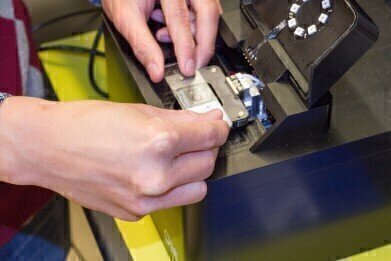Microscopy & Microtechniques
Super-resolution Microscope Helps Researchers Understand Cell Functionality Emerging from Interactions between Proteins
Jun 23 2017
The BioMAN Laboratory is headed up by Assistant Professor Rizal Hariadi. It is located in the Biodesign Institute and in the Physics Department at Arizona State University (ASU) in Tempe. The Lab’s main interest is to uncover the fundamental physical forces that govern how cells generate, detect, and respond to mechanical forces at the molecular level.
Professor Hariadi's goal is to combine single molecule FRET, super-resolution microscopy, and DNA nanotechnology to elucidate how these cellular functions emerge from interactions between single molecules in cells. Single molecules are much smaller than the diffraction limit of the light microscope. Consequently, it can be difficult to determine interaction with enough spatial resolution to get meaningful insight. In combination with ensemble fluorescence microscope and molecular dynamics simulation, the Lab exploits single molecule localisation microscopy to visualise the dynamics and partitioning outer membrane proteins in bacteria. This need led the Lab to the selection of the Nanoimager from Oxford Nanoimaging, ONI.
Professor Hariadi related: “I spoke with ONI founder, Bo Jing, and he convinced me that the Nanoimager would deliver nearly all the performance requirements I defined. His knowledge of super-resolution technology and ability to handle my questions about sample preparation and experimental protocols has been invaluable. I have been very pleased to see the very stable design along with the ability for ‘perfect focus’ through the choice of lenses. The key feature that differentiates the Nanoimager from other systems is the ability for real time image analysis. I note that all components have been carefully selected to make top quality instrument. Most recently, ONI has agreed to add temperature control to the Nanoimager which will increase the already excellent level of image stability.”
SU PhD student, Franky Djutanta, is one of the users of the Nanoimager. He likes “the way the Nanoimager is built. It gives us a straightforward means to acquire the images in a way that requires almost no experimental setup. The hardware and software are so well-thought and well-designed. We truly love this capability since it gives us more time to think about our ideas and science and on to our future papers and personal life as well.”
Digital Edition
Lab Asia 31.2 April 2024
April 2024
In This Edition Chromatography Articles - Approaches to troubleshooting an SPE method for the analysis of oligonucleotides (pt i) - High-precision liquid flow processes demand full fluidic c...
View all digital editions
Events
Apr 28 2024 Montreal, Quebec, Canada
May 05 2024 Seville, Spain
InformEx Zone at CPhl North America
May 07 2024 Pennsylvania, PA, USA
May 14 2024 Oklahoma City, OK, USA
May 15 2024 Birmingham, UK


















